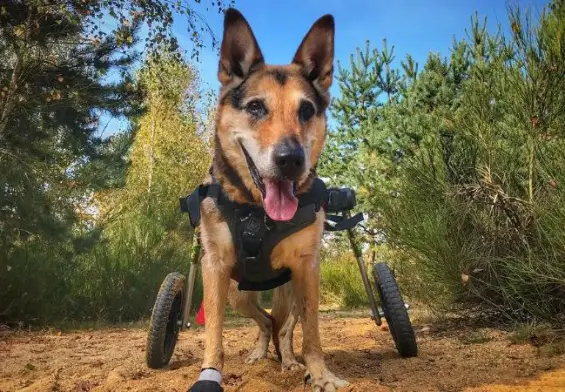Stages & Symptoms of Dog Dying from Liver Failure
You love your dog so much that you cannot bear to see it in pain. It even hurts you more to let it go when it is time for euthanasia. It always is a tough decision to make, probably the toughest you’d ever make.
Many diseases affect dogs that lead to the point of choosing death as a less painful option, and liver failure falls into this category. Many authority websites claim that liver failure in dogs is the fifth primary reason dogs die. Liver failure doesn’t just lead to the death of your dog but also reduces its quality of life.
Nothing should be more important to you regarding your dog than a good living standard. Your dog’s quality of life should be the standing factor when you make that decision for euthanasia.
When to Euthanize A Dog with A Failed Liver
The longer the time you give the disease to thrive in your dog, the less the quality of life of your dog. When to euthanize your dog is both a hard question to answer, as it is tough to ask.
When your dog screeches in pain, cannot walk, run, eat, and carry out daily functions due to the failure, consider euthanasia. On a normal day, these are things your dog should do with no form of help.
It gives a lot of emotional pain for us to let go of our dogs to euthanasia, even with all these signs. It is best to visit a vet and seek help/advice from loved ones and friends.
Questions run through your mind endlessly, you look back at the memories, the good days, and the bad days. These thoughts would not want you to let go so easily. It is better to be objective in your decision here, ask yourself the following questions:
- Can my dog walkabout?
- Can my dog go use the toilet and eat without having pains?
- Is my dog able to stand up from a lying position?
If no is the answer to these questions, then you need to consider that the suffering is too much for your dog. You need to decide that the time is ripe for your dog to be euthanized. You need to be prepared also for the aftermath.
It is best to take the better decision; stop your dog from suffering too much and let it go. The answers to these questions reflect the quality of your dog’s life, and from the look of things, a “no” means your dog’s suffering too much.
How Long Can Your Dog Survive with Liver Failure?
The disease in question is a progressive one. It starts from the early stages and then moves on to the final stage/ end-stage. At the end-stage, the result is usually fatal.
The rate of the development of severity for liver failure is different for every dog. For some dogs, the progression of damage happens faster, while for others, it is slow. Hence, there is a need to be mindful of the signs of discomfort in your dog and not ignore anything.
In the first stage of liver failure, there is abnormal inflammation, present in the liver tissue of your dog. The reason for the inflammation is an underlying disease entity. At this stage, the liver of your dog can still carry on with its function, but with a very limited capacity.
Nausea, vomiting, tiredness, and loss or change in appetite would set in at this early stage. If your vet quickly diagnoses this disease in your dog, the progress of the disease would be slowed down with the use of supplements.
At the middle stage of the disease, certain other things become more apparent as compared to the first. One thing that stands out is the yellowish coloration of your dog’s gums, skin, and eyes, which is called Jaundice.
The liver functions in the production of a unique protein known as Albumin. This protein helps to lock in fluids in the blood vessels to prevent leakage. In liver failure, the capacity of your liver to produce this protein is greatly diminished, hence, the fluids accumulate in your dog’s abdomen.
Abdominal distention is an alarm sign of liver failure in your dog, don’t take it lightly.
At the end of the spectrum is the last stage of liver failure. At this stage, certain neurological problems set in for your dog. Some of them include seizure, dizziness, disorientation, signs of blindness, wandering and pacing, depression, and a change in mentality.
With end-stage liver failure, your dog develops a condition called hepatic encephalopathy. The liver is a detoxifying organ and liver failure makes removing metabolites and metabolizing proteins becomes impossible. This then leads to a buildup of these toxins in your dog’s body, causing the symptoms we stated earlier.
How To Aid A Dog That Has Liver Failure
You can only help your dog that has reached the end-stage of liver failure by treating the pain and the symptoms. There is nothing that can be done to reverse it. The various symptoms previously highlighted can be treated with the use of anti-diarrheal meds, pain relievers, and other anti-nausea medications.
Veterinarians also treat any other underlying conditions if present.
In other to help boost your dog’s quality of life, veterinarians prescribed certain foods and supplements that you can give to your dog. These foods help to prevent neurological symptoms mentioned earlier and can be digested easily.
One thing that comes as a result of liver failure is oxidative damage. There are also specially-formulated supplements for preventing this damage.
Early diagnosis of liver failure can help you carry out measures that sustain the life of your dog for months to even many years. Late diagnosis leads to late prognosis, as most cases that are diagnosed late, often barely survive a few weeks or even a few months.
For your dog to survive for long, certain factors have to come into play such as therapy, lifestyle, diet, and the ability of your dog to combat the disease. Even if your hands are tied as to how much you could do to save your dog with an already existing liver failure condition, you can improve its quality of life.
Canine Liver Failure
The liver is an interesting organ that plays a vital role in the body; it is one of the vital organs of the body. With a capacity for self-healing, it defends itself from injury and diseases, including permanent damage.
Some functions carried out by the liver include metabolizing proteins, storage, production of plasma proteins (albumin), and digestion. The liver is the principal organ for detoxifying the body.
Adversely, its role in the body makes its damage very fatal to the entire body. That is the more reason why pet owners have to make firm decisions to euthanize their dogs if the need arises.
Every day the liver is exposed to toxins due to its role as the body’s detoxifier. Constant and repeated exposure to toxins may cause the liver to get damaged. These toxins can eat up ¾ of the liver tissue and cause damage.
Other factors that lead to liver damage include chronic inflammation, blood, cancer, immune diseases, vessel abnormalities, and so on.
Signs That A Dog Is Dying from Liver Damage
Physical as well as mental problems set in when there is a buildup of toxins in your dog’s body. Symptoms like lethargy, depression, dizziness, and other strange behaviors are common with dogs that have liver failure.
The signs of liver failure or damage vary from dog-to-dog. Here are a few signs that prove that your dog has liver failure:
- Fever
- Jaundice (the yellow tinge on the sclera, gums, and skin of your dog)
- Diarrhea
- Seizures
- Weight loss
- Vomiting
- Changes in the size of the liver
- Issues with blood clotting
- Weight loss
- Abdominal distention, as a result of excessive fluid accumulation.
- Issues with blood clotting
Sometimes, the signs of liver failure may be subtle and difficult to dee and even identify. It is pretty easy for most pet owners to miss out on these signs because they are similar to those of other diseases.
Think about what can happen when there is an accumulation of poisonous substances within the liver. Since the liver is the detoxifier, what would happen if it is destroyed. Sadly, the most vulnerable organ to toxins is the one that saves the body from the same, and its failure is bad news for your dog’s health.
Conclusion
The liver is said to have failed when it has sustained damage so much that it cannot carry out its functions. Due to the nature of the liver failure to progress rapidly, it cannot be compared to any other disease. It kills faster than most diseases that might affect your dog.
As a result, it is advisable to prevent your dog from suffering and let it go via euthanasia. The quality of your dog’s life is more paramount than your emotional sentiments.
Remember to not decide without properly consulting your veterinarian.





